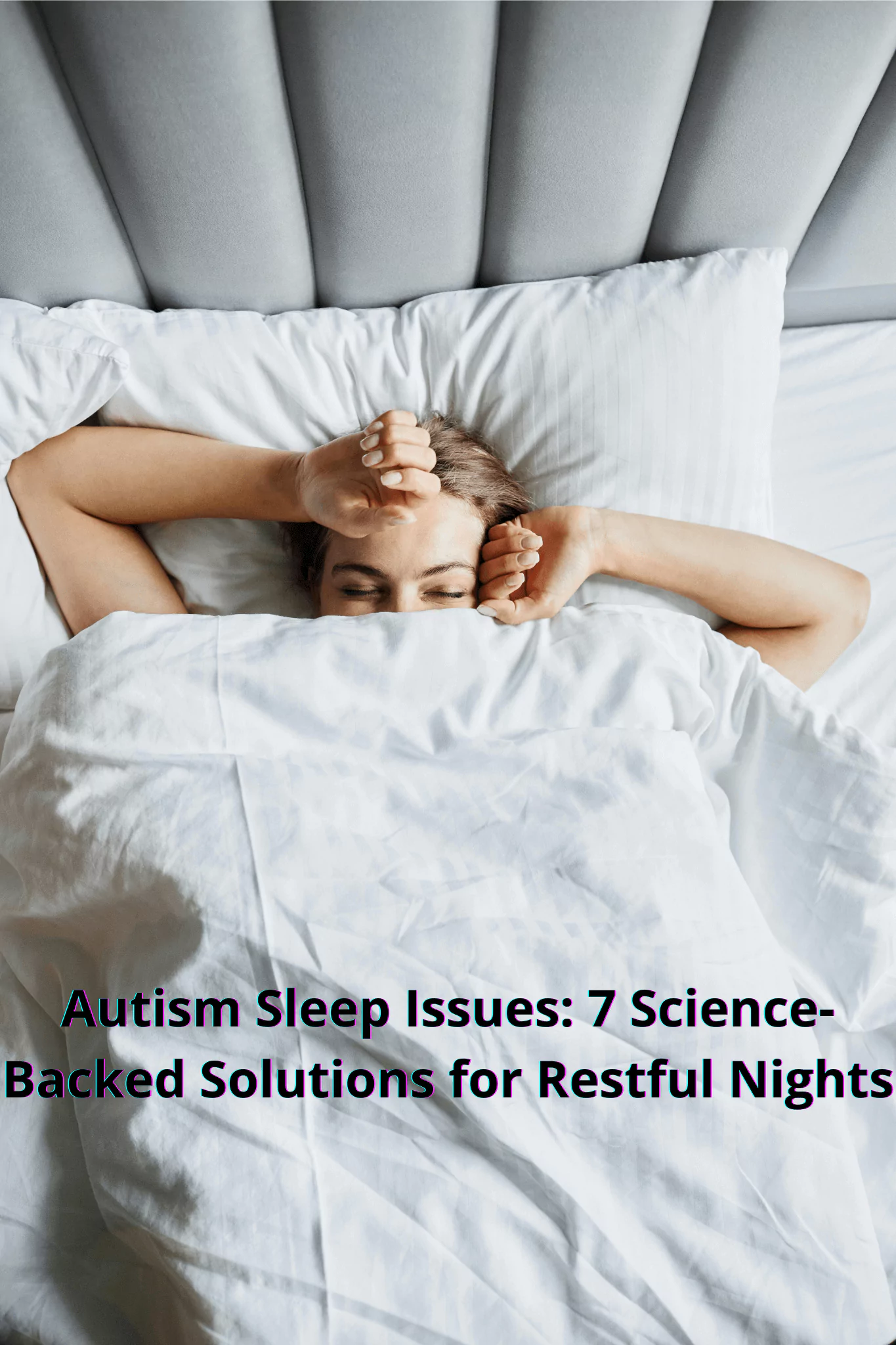With 9 years of experience in the kitchen, I’m passionate about crafting delicious recipes and sharing them with food lovers worldwide. 🍽️✨ Whether it’s a comforting homemade dish or a creative cocktail, my goal is to make cooking fun, easy, and enjoyable for everyone. Join me on this flavorful journey! 🍹🥗

Autism Sleep Issues: 7 Science-Backed Solutions for Restful Nights
Autism Sleep Issues: 7 Science-Backed Solutions for Restful Nights
Navigating the world with autism spectrum disorder (ASD) presents unique challenges, and one of the most prevalent yet often overlooked is the struggle with sleep. Sleep disturbances in autism are incredibly common, affecting a significant percentage of individuals with ASD. These challenges can range from difficulty falling asleep and staying asleep to frequent night wakings and early morning awakenings. Understanding the complexities of these sleep disturbances and implementing evidence-based strategies is crucial for improving the quality of life for both individuals with autism and their families.
This comprehensive guide explores the science behind autism and sleep, offering seven practical, science-backed solutions to promote restful nights. By addressing the underlying factors that contribute to sleep problems in autism, we aim to provide effective strategies that can be tailored to individual needs.
Understanding Autism and Sleep
The connection between autism and sleep is complex and multifaceted. Research suggests that individuals with ASD often have differences in their circadian rhythm, the internal biological clock that regulates sleep-wake cycles. These differences can lead to difficulties in initiating and maintaining sleep. Furthermore, sensory sensitivities, common in autism, can make it challenging to create a comfortable and conducive sleep environment. Factors such as light, noise, and tactile sensations can significantly impact sleep quality.
Additionally, co-occurring conditions such as anxiety, ADHD, and gastrointestinal issues can further exacerbate sleep disturbances in autism. These conditions often require specific interventions to address their impact on sleep. Understanding these underlying factors is the first step in developing effective strategies to improve sleep.
It’s important to note that sleep problems in autism can have significant consequences on daily functioning. Lack of sleep can lead to increased irritability, difficulty concentrating, behavioral problems, and impaired social interactions. Addressing sleep issues is therefore crucial for improving overall well-being and quality of life. Learn more about our mission to support individuals with autism.
Establishing a Consistent Sleep Schedule
One of the most effective strategies for addressing sleep challenges in autism is establishing a consistent sleep schedule. This involves going to bed and waking up at the same time every day, even on weekends. Consistency helps regulate the circadian rhythm and promotes a more natural sleep-wake cycle. A predictable routine signals to the body when it’s time to sleep, making it easier to fall asleep and wake up refreshed.
Tips for Creating a Consistent Sleep Schedule
- Set a Realistic Bedtime and Wake-Up Time: Choose a bedtime that allows for adequate sleep duration based on age. For children with autism, 9-11 hours of sleep is generally recommended.
- Maintain a Regular Sleep-Wake Cycle: Stick to the same sleep schedule every day, even on weekends and holidays. Avoid significant deviations from the routine.
- Use Visual Supports: For individuals with autism who benefit from visual aids, create a visual schedule that outlines the bedtime routine and reinforces the importance of consistency.
- Gradual Adjustments: If significant changes to the sleep schedule are needed, make gradual adjustments of 15-30 minutes per day to allow the body to adapt.
Implementing a consistent sleep schedule requires patience and persistence. It may take several weeks to establish a regular sleep-wake cycle. However, the long-term benefits of improved sleep quality and daily functioning make it a worthwhile effort. Explore our services to help implement this strategy.
Optimizing the Sleep Environment
Creating a sleep environment that is conducive to rest is crucial for individuals with sleep disturbances related to autism. Sensory sensitivities can significantly impact sleep quality, making it essential to optimize the sleep environment to minimize distractions and promote relaxation. This involves addressing factors such as light, noise, temperature, and bedding.
Strategies for Optimizing the Sleep Environment
- Minimize Light Exposure: Use blackout curtains or blinds to block out external light sources. Darkness promotes the production of melatonin, a hormone that regulates sleep. Consider using a red-tinted night light, as red light has been shown to have less impact on melatonin production.
- Reduce Noise Levels: Use earplugs, a white noise machine, or a fan to mask distracting noises. Soundproofing the room can also be beneficial.
- Maintain a Comfortable Temperature: Keep the room at a cool and comfortable temperature. The ideal temperature for sleep is typically between 60 and 67 degrees Fahrenheit (15.5 to 19.4 degrees Celsius).
- Choose Comfortable Bedding: Select bedding made from soft, breathable materials. Avoid scratchy or irritating fabrics. Consider using a weighted blanket, which can provide a calming and comforting sensation for some individuals with autism.
- Create a Clutter-Free Space: A cluttered and disorganized room can be visually stimulating and distracting. Keep the sleep environment clean and organized.
By carefully optimizing the sleep environment, you can create a more relaxing and conducive space for sleep, helping to improve sleep quality and reduce disturbances. Contact us here for more assistance.
Implementing Sensory Strategies for Sleep
Sensory sensitivities are a hallmark characteristic of autism, and these sensitivities can significantly impact sleep. Implementing sensory strategies can help individuals with sleep challenges regulate their sensory input and promote relaxation before bed. These strategies involve using sensory tools and techniques to create a calming and predictable bedtime routine.
Effective Sensory Strategies for Sleep
- Weighted Blankets: Weighted blankets provide deep pressure stimulation, which can have a calming and grounding effect. The weight of the blanket can help reduce anxiety and promote relaxation.
- Sensory Swings: Gentle swinging can be very calming and can help regulate sensory input. A sensory swing can be incorporated into the bedtime routine as a way to wind down.
- Massage Therapy: Gentle massage can help relax muscles and reduce tension. Consider incorporating a massage into the bedtime routine, focusing on areas such as the back, shoulders, and feet.
- Aromatherapy: Certain scents, such as lavender and chamomile, have been shown to promote relaxation and sleep. Use essential oil diffusers or add a few drops of essential oil to a warm bath before bed.
- Tactile Activities: Engaging in tactile activities such as playing with playdough, squeezing a stress ball, or using a textured blanket can help regulate sensory input and reduce anxiety.
It’s important to experiment with different sensory strategies to determine what works best for the individual. Sensory preferences vary widely, so it’s essential to tailor the strategies to individual needs and sensitivities. The National Autistic Society provides further information on sensory processing: https://www.autism.org.uk/
Dietary Considerations for Better Sleep
Diet plays a crucial role in sleep regulation, and dietary adjustments can often help improve sleep disturbances in autism. Certain foods and drinks can interfere with sleep, while others can promote relaxation and sleepiness. Paying attention to dietary habits and making strategic changes can significantly impact sleep quality.
Dietary Tips for Promoting Sleep
- Limit Caffeine Intake: Avoid caffeine-containing beverages such as coffee, tea, and soda, especially in the afternoon and evening. Caffeine is a stimulant that can interfere with sleep.
- Reduce Sugar Consumption: High sugar intake can lead to blood sugar spikes and crashes, which can disrupt sleep. Limit sugary foods and drinks, especially before bed.
- Avoid Processed Foods: Processed foods often contain additives and preservatives that can interfere with sleep. Focus on whole, unprocessed foods such as fruits, vegetables, and lean protein.
- Increase Tryptophan Intake: Tryptophan is an amino acid that is a precursor to serotonin and melatonin, both of which promote sleep. Foods rich in tryptophan include turkey, chicken, nuts, seeds, and bananas.
- Consider Magnesium-Rich Foods: Magnesium is a mineral that helps relax muscles and promote sleep. Foods rich in magnesium include leafy green vegetables, nuts, seeds, and whole grains.
In addition to making dietary changes, it’s important to ensure adequate hydration throughout the day. Dehydration can lead to fatigue and disrupt sleep. Drinking a glass of water before bed can help prevent dehydration during the night. A consultation with a registered dietitian can provide personalized dietary recommendations for addressing sleep challenges. According to the Mayo Clinic, following a balanced diet can improve sleep quality: https://www.mayoclinic.org/
Behavioral Therapy Techniques for Sleep
Behavioral therapy techniques can be highly effective in addressing sleep disturbances in autism, particularly when combined with other strategies such as establishing a consistent sleep schedule and optimizing the sleep environment. These techniques focus on modifying behaviors and thought patterns that interfere with sleep. Cognitive Behavioral Therapy for Insomnia (CBT-I) is a commonly used approach that can be adapted for individuals with autism.
Effective Behavioral Therapy Techniques for Sleep
- Stimulus Control Therapy: This technique involves associating the bed with sleep and limiting activities in bed to sleep and intimacy. If the individual is unable to fall asleep after 20 minutes, they should get out of bed and engage in a relaxing activity until they feel sleepy, then return to bed.
- Sleep Restriction Therapy: This technique involves limiting the amount of time spent in bed to match the actual amount of time spent sleeping. This can help consolidate sleep and improve sleep efficiency.
- Relaxation Techniques: Practicing relaxation techniques such as deep breathing, progressive muscle relaxation, and guided imagery can help reduce anxiety and promote sleep.
- Cognitive Restructuring: This technique involves identifying and challenging negative thoughts and beliefs about sleep. Replacing negative thoughts with more positive and realistic ones can help reduce anxiety and improve sleep.
- Positive Reinforcement: Using positive reinforcement to reward desired sleep behaviors, such as following the bedtime routine and staying in bed, can help motivate individuals with autism to improve their sleep habits.
Working with a qualified behavioral therapist who has experience working with individuals with autism is essential for developing and implementing effective behavioral therapy techniques for sleep. A therapist can tailor the techniques to the individual’s specific needs and challenges.
Exploring Medical Interventions
In some cases, medical interventions may be necessary to address sleep disturbances in autism, particularly when other strategies have been unsuccessful. Medical interventions may include medications, supplements, and other therapies. It’s important to consult with a healthcare professional to determine the most appropriate medical interventions for the individual.
Common Medical Interventions for Sleep
- Melatonin Supplements: Melatonin is a hormone that regulates the sleep-wake cycle. Melatonin supplements can help improve sleep onset and duration in individuals with autism.
- Prescription Medications: In some cases, prescription medications such as sedatives or antidepressants may be necessary to address underlying conditions such as anxiety or depression that are interfering with sleep.
- Iron Supplementation: Iron deficiency can contribute to restless legs syndrome, which can disrupt sleep. Iron supplementation may be beneficial for individuals with autism who have iron deficiency.
- Magnesium Supplements: Magnesium supplements can help relax muscles and promote sleep.
- Other Therapies: Other therapies such as light therapy and cranial-sacral therapy may also be helpful in addressing sleep challenges.
It’s important to note that medical interventions should be used in conjunction with other strategies such as establishing a consistent sleep schedule and optimizing the sleep environment. Medical interventions should also be closely monitored by a healthcare professional to ensure safety and effectiveness.
Creating a Personalized Sleep Plan
Addressing sleep challenges in autism requires a personalized approach. What works for one individual may not work for another. Creating a personalized sleep plan involves assessing the individual’s specific needs and challenges, identifying effective strategies, and implementing those strategies consistently. The plan should be flexible and adaptable to changing needs.
Steps for Creating a Personalized Sleep Plan
- Assess Sleep Habits: Keep a sleep diary to track sleep patterns, bedtime routines, and factors that may be contributing to sleep problems.
- Identify Underlying Factors: Determine if there are any underlying medical or behavioral conditions that are contributing to sleep problems.
- Set Realistic Goals: Set realistic goals for improving sleep quality and duration.
- Implement Strategies: Implement a combination of strategies such as establishing a consistent sleep schedule, optimizing the sleep environment, implementing sensory strategies, making dietary changes, and using behavioral therapy techniques.
- Monitor Progress: Monitor progress regularly and make adjustments to the sleep plan as needed.
- Seek Professional Support: Work with a healthcare professional, behavioral therapist, or sleep specialist to develop and implement the sleep plan.
Creating a personalized sleep plan requires patience, persistence, and a willingness to adapt. By taking a personalized approach, you can increase the likelihood of success and improve sleep quality for individuals with sleep challenges.
Frequently Asked Questions (FAQ)
Are melatonin supplements safe for children with autism who struggle with sleep disturbances?
Melatonin supplements are generally considered safe for short-term use in children with autism who experience sleep difficulties. However, it’s crucial to consult with a pediatrician or healthcare provider before starting melatonin, as they can determine the appropriate dosage and monitor for any potential side effects. Long-term safety data is still emerging, so medical guidance is essential.
What are some common signs that a child with autism is not getting enough sleep?
Common signs of sleep deprivation in children with autism include increased irritability, difficulty concentrating, hyperactivity, aggression, increased repetitive behaviors, and regression in skills. They may also exhibit more meltdowns or have a harder time regulating their emotions and behaviors. Poor sleep can significantly impact their daily functioning and overall well-being.




